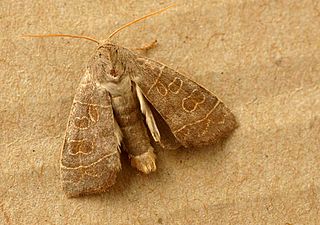
Apamea crenata, known as the clouded-bordered brindle, is a moth in the family Noctuidae. It is distributed throughout the Palearctic realm. In the North it crosses the Arctic Circle, in the Mediterranean it is found only in cool locations and mountains avoiding very hot areas. In the Alps, it rises to an altitude of about 2000 metres.

Miletus symethus, the great brownie, is a small butterfly found in India that belongs to the lycaenids or blues family. The species was first described by Pieter Cramer in 1777.

Nacaduba pavana, the small four-line blue or Singapore four-line blue, is a species of lycaenid butterfly found in Southeast Asia.

Ipimorpha subtusa, the olive, is a moth of the family Noctuidae. It is found in the Palearctic realm.

Hoplodrina blanda is a moth of the family Noctuidae. It is found in the Palearctic realm.

Noctua fimbriata, the broad-bordered yellow underwing, is a moth of the family Noctuidae. It is found in Europe, North Africa, Anatolia, the Caucasus, Turkey, Caucasus, Transcaucasia, Armenia, Turkmenistan and Novosibirsk Oblast. The border of its southern range is unclear because of the similar looking species Noctua tirrenica.

Polia bombycina is a moth of the family Noctuidae. It is found in the Palearctic realm from Ireland to Japan including the Russian Far East and Siberia.

Xanthia icteritia, the sallow, is a moth of the family Noctuidae. It is found in the Palearctic realm.

Podalia is a genus of moths in the family Megalopygidae.

Ratarda excellens is a moth in the family Cossidae. It is found in Taiwan.
Megalopyge tharops is a moth of the family Megalopygidae. It was described by Caspar Stoll in 1782. It is found in French Guiana and Brazil.
Podalia bolivari is a moth of the family Megalopygidae. It was described by Franciscus J. M. Heylaerts in 1884. It is found in Panama and Venezuela.
Podalia fuscescens is a moth of the family Megalopygidae. It was described by Francis Walker in 1856. It is found in Brazil.
Podalia lanocrispa is a moth of the family Megalopygidae. It was described by E. Dukinfield Jones in 1912. It is found in Brazil.
Podalia mallas is a moth of the family Megalopygidae. It was described by Herbert Druce in 1899. It is found in Brazil.
Podalia nivosa is a moth of the family Megalopygidae. It was described by E. Dukinfield Jones in 1912. It is found in Brazil.

Podalia orsilochus is a moth of the Megalopygidae family. It was described by Pieter Cramer in 1775. It is found in Mexico, Costa Rica, Brazil, Guyana and Venezuela.
Podalia schadei is a moth of the Megalopygidae family. It was described by William Schaus in 1924. It is found in Paraguay.
Podalia thanatos is a moth of the Megalopygidae family. It was described by William Schaus in 1905. It is found in Costa Rica and Guyana.
Podalia walkeri is a moth of the Megalopygidae family. It was described by Carlos Berg in 1882 and is found in Brazil.










